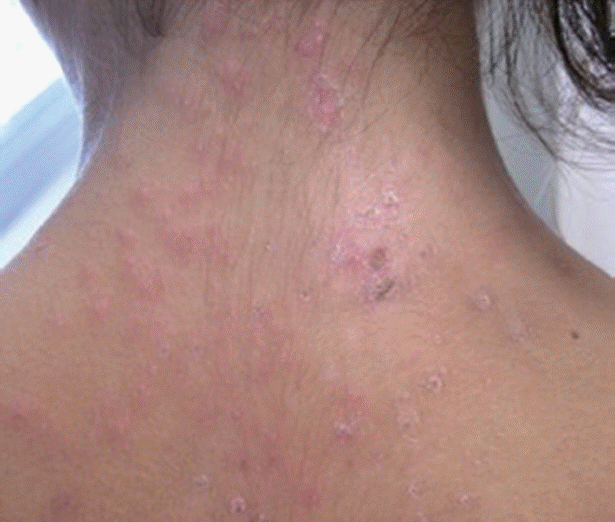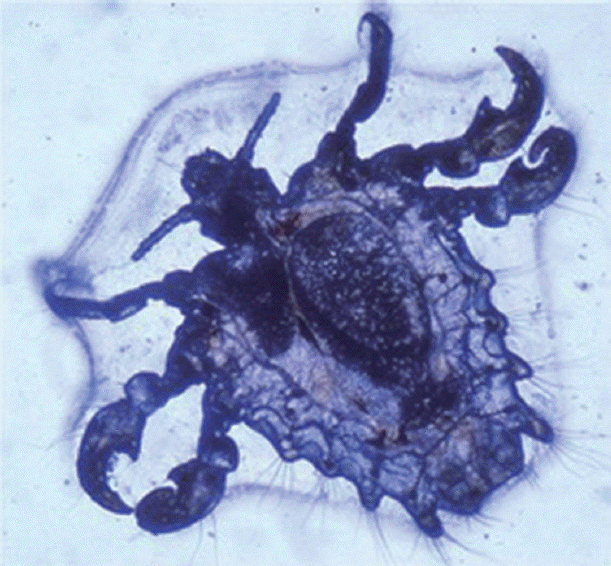INTRODUCTION
Phthirus pubis Linnaeus, 1758 (Diptera: Anoplura), popularly known as crab louse, usually infests the pubis, groin, buttocks and perianal region. However, it can also infest, in particular in hairy males, the thighs, abdomen, chest, axillae and beard. Eyelashes and eyebrows are sometimes involved in children. The involvement of the scalp is very rare. We describe a case of P. pubis infestation located exclusively on the scalp in an adult woman.
CASE RECORD
A 37-year-old Italian woman was admitted because of a rash on the nape, shoulders and upper portion of the back. The patient stated she was in good general health and that she was not in therapy with systemic drugs. She also declared that the rash had appeared approximately 2 months before, a few days after her return from a trip to Vietnam and China. The rash was diagnosed at other centers as allergic contact dermatitis and unsuccessfully treated with topical corticosteroids and oral antihistamines. The patient complained of severe itching on the scalp, neck, shoulders and upper portion of the back.
Dermatological examination revealed several isolated or confluent, roundish, erythematous papules, covered by scales, on the nape, shoulders and upper portion of the back (Fig. 1). Furthermore, numerous nits and adults of P. pubis were observed on the scalp (Fig. 2). Microscopical examinations confirmed that the lice were P. pubis. Neither lice/nits nor skin lesions were observed elsewhere, including eyebrows, eyelashes, axillae, pubis, buttocks and perianal region (the patient was hairless in the axillae and pubis). Dermatological examination of the patient’s husband and children (a 17-year-old girl and a 15-year-old boy) was negative. According to the patient’s history, both children were never affected by scalp pediculosis. It was therefore impossible to trace the source of the infestation. Bacteriological and mycological examinations were negative.
The patient was successfully treated with a foam containing 0.165% pyrethrins and 1.65% piperonylbutoxide (1 application/day for 2 days; the treatment was repeated 10 days later). Follow up (10 months) was negative.
DISCUSSION
The first case of scalp involvement by P. pubis was published in 1892 [1]. Since then, approximately 20 cases have been published [1–14]. The involvement of the scalp by this louse is therefore considered as very rare, although it is likely underestimated. However, this is the first case of scalp involvement by P. pubis we have observed in the last 35 years at our Dermatology Unit. The reason of the rarity of P. pubis infestation on the scalp is unknown. The hypothesis according to which this louse grows only in areas rich in apocrine glands is not convincing, because these glands are very rare on the scalp [1]. All cases reported so far have been Caucasians or Asians. According to the photographs reported in the articles, all patients had straight hair [2,4,9,12,13]. Cases have been observed in France [12], Turkey [14], Israel [7], India [1], China [11], Taiwan [9], Japan [8,13], Malaysia [10], Canada [6] and United States [2–5]. The infestation was diagnosed in children [1,3,6–8,10, 11,14] as well as in adults [2–5,9,10,12,13]. Several authors observed on the scalp, in addition to nits, more or less numerous adults of P. pubis [2–5,11]: this is in contrast to infestations caused by Pediculus humanus capitis De Geer, 1767, where the lice are often difficult to observe [2]. As previously mentioned, we found on the scalp of our patient several adults of P. pubis. A co-infestation on the scalp by both P. humanus capitis and P. pubis was diagnosed in 2 siblings [1]. An additional important difference between the 2 infestations is pruritus: the latter is very common and severe in P. pubis infestation on the scalp [2,4,5,9,11]. This explains the frequent observation of excoriations due to scratching [2,5]. The occipital region, nape and upper portion of the back, as in our patient, are most involved [1–5]. It is interesting to observe that in some patients the infestation occurred only on the scalp: no involvement of other skin regions, such as the pubis, were observed [1,4,5]. Also, in our patient the infestation involved only the scalp.
Although a very small number of patients with P. pubis infestation on the scalp has been reported in the literature, it is possible that it is misdiagnosed as pediculosis caused by P. humanus capitis. As suggested by some authors [5], microscopical examination of the lice observed on the scalp is helpful for a correct etiological diagnosis.





